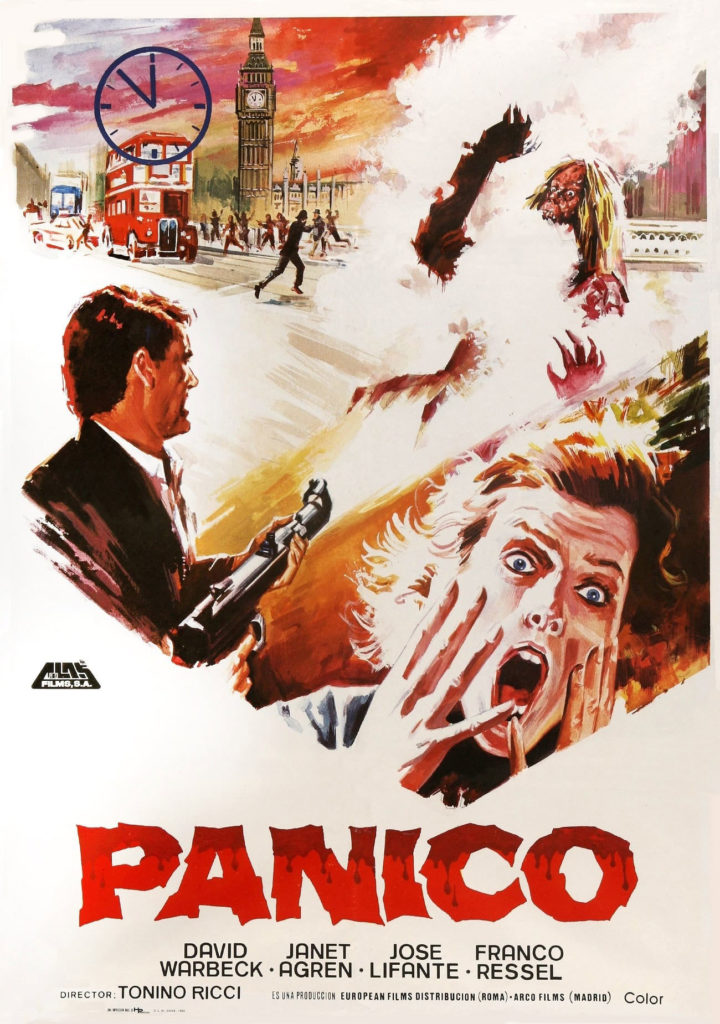Horror flicks from Italy are some of the most beloved films the genre has to offer. They have a style that is instantly recognizable. Names of auteurs — Argento, Bava, et al — are known and discussed with reverence by fans. But, like film industries all over the planet, there is a fair amount of chaff among the wheat. Case in point: Panic, a bottom-feeding horror flick released under a number of titles, including as an entry in the confusing Zombi series of films.
From screenwriters Victor Andrés Catena and Jaime Comas Gil, and directed by Tonino Ricci, Panic is quite a departure from other films featured in this year’s Horrorshow. It’s not gothic, nor is it a descendant of giallo. There are no supernatural elements and no lip service to the Catholic Church. If anything, this film, in tone and style, is reminiscent of 1950s and early 1960s British science fiction, along the lines of the Quatermass films. In other words, it’s talky.
A joint Italian/Spanish production, Panic tells the tale of a horribly disfigured scientist who is terrorizing an English town, and efforts to stop him before the Royal Air Force bombs the town into oblivion. Information is scant, but it appears much of the exteriors were shot in Spain, with some stock footage used to establish England as the location of the story.
David Warbeck stars as, and I am not making this up, Captain Kirk, a Canadian police officer who has transferred to the UK. After an accident at a lab has potentially released a deadly contagion and one of the scientists has gone missing, he is sent to investigate and eliminate any threat that may present itself. He is assisted by police sergeant  O’Brien (José Lifante), and Jane Blake (Janet Agren), another scientist from the lab.
O’Brien (José Lifante), and Jane Blake (Janet Agren), another scientist from the lab.
As noted above, the missing scientist, Professor Adams, has been transformed into a hideous monstrosity by the accident, and is stumbling and moaning his way through the town, ripping the townsfolk to shreds. Rino Carboni is credited with creating the creature makeup worn by Roberto Ricci, who played Adams. It’s a nasty bit of work. But, like all the gore in this film, is the product of a constrained budget.
Most of the film features Adams getting in a kill, followed by Kirk and O’Brien having conversations with townsfolk. Rinse, and repeat. It’s this method of storytelling that makes the film feel like something Hammer or the BBC would have made a couple of decades earlier. Those productions were talky for the simple reason that scenes of dialogue are cheap to film. It would seem that’s the case with Panic, but it’s also a step backwards in terms of film storytelling. By 1982, when Panic was released, there were more efficient ways of disguising a film’s origins in poverty. For one, this flick is 90-minutes long. Some ruthless cutting would have done much to help.
Panic will be a tough watch for many who decide to view it. It starts very poorly before rallying somewhat after the first act. Still, it’s a b-movie through and through. There is nothing that can disguise that. It’s also a film that hasn’t been cared for since its release. The print I saw was formatted for CRT televisions and the color was washed. Some scenes were so dark it was impossible to see what was happening. This is one of those films that is slipping into the ether, with no one able, or willing, to save it before its ultimate digital decay.
Panic, or Bakterion, or whatever one wants to call it, has little to recommend it as a bad movie watch. There’s no mirth, little talent, and it can’t keep a viewer’s attention. Thus, it slips down into the nether regions of the Watchability Index, displacing Attack Force at #419. Stay away.
